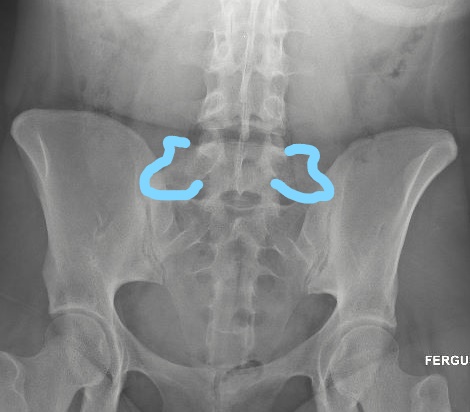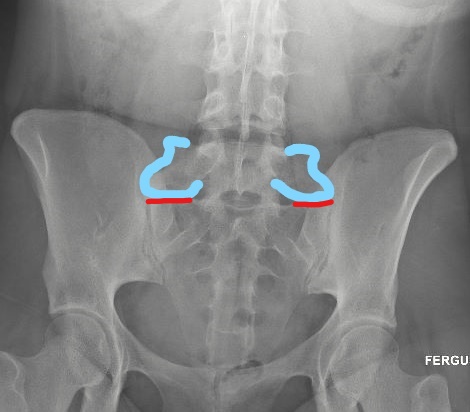What is Bertolotti’s Syndrome?
Bertolotti’s Syndrome involves the lowest vertebra in the
back; the one just above the sacrum, called the L5 vertebra.
Basically, Bertolotti’s Syndrome is an abnormal development
of the L5 vertebra, which occurred in utero.
Normally the L5 vertebra is completely mobile (with a normal disc) and
whose transverse processes do NOT touch the sacrum (the vertebra just below
L5). In Bertolotti’s the L5 transverse
processes can articulate or connect to the sacrum, on one or both sides.
On the below radiograph of the pelvis, the enlarged
transverse processes are outlined in blue.
Below, the red lines demonstrate the abnormal articulation
between the Bertolotti’s and the sacrum, which is the area which is causing
pain.
Are there different
types?
In Type 1 there is very little articulation between the L5
transverse processes and the sacrum.
In Type 2, one or both sides, the articulation is larger and
the L5-S1 disc space is slightly narrower than normal. This is due to this motion segment never
having moved normally, so a narrow disc typically develops.
In Type 3 there is an actual bony bridge between the L5
transverse process(es) and the sacrum.
In this type there is a very narrow L5-S1 disc space.
Do all Bertolotti’s
cause pain?
The answer is “no”.
Type 1 infrequently have symptoms, and typically do not need much
treatment (nonsurgical or surgical). This is because there is not much of a
Bertolotti’s so motion at L5-S1 is much more normal. In addition the larger the actual bony
connection on one or both sides (type 3 and 4), the less symptoms are typically
present as there is very little motion at the L5-S1 motion segment.
Hence, the type which have the most symptoms are the Type
2. The reason is there are moderately
sized L5-S1 discs, so there is some motion at the L5-S1 motion segment. This motion can cause pain at the abnormal
L5-S1 Bertolotti’s deformity as this connection is stiffer, and the bone of the
Bertolotti’s can cause pain, much like a stress fracture.
Where is pain
associated with Bertolotti’s?
Most pain with Bertolotti’s is in midline in the low back.
How do you treat
Bertolotti’s pain?
Essentially, you start treatment with the same regimen as
you would if it were not present: Physiotherapy, over-the-counter analgesic
medications, and activity modification is usually the first level of treatment?
What happens if pain
persists despite the above-mentioned therapies?
The next step is to obtain advanced imaging, which can be
MRI or CT scan. These imaging modalities
can help rule out other causes of low back pain, which can create pain in the
same location as Bertolotti’s. A CT scan
can beautifully identify the 3-d structure of a Bertolotti’s, and a 3-d
reconstruction of the CT can be very helpful in diagnoses and treatment.
Are there any
additional interventions which may help with the diagnosis and/or treatment of
Bertolotti’s?
Yes there is……and it involves an injection into the area of
the Bertolotti’s under radiographic localization. The injection usually consists of a steroid
and some local anesthetic, so if the injection is at the pain generator (the
Bertolotti’s) then the patient should get some temporary relief with the local
anesthetic component of the injection, and the steroid may provide some longer
lasting relief.
So which patients go
to surgery?
The pain has to be persistent and nonsurgical management
(physiotherapy, over-the-counter analgesics, and activity modification) have
not adequately relieved the back pain (to the patients’ satisfaction), AND has
to have had some pain relief from the injection (even if only short-term, only
hours of pain relief).
What is “surgery” for
Bertolotti’s?
Usually the surgical procedure for Bertolotti’s is resection
of the transverse process of L5 (one or both) to fully mobilize the L5-S1
vertebral motion segment. This is done
through a one or two-incision approach in an open (regular incision) or
minimally-invasive method (through tube system).
However, if there are large articulations between L5 and S1
and the disc at L5-S1 is very narrow, then a definitive posterior spinal fusion
can be a better procedure to mitigate low back pain.
The below radiograph is the patient after surgery. Notice the absence of the large transverse
process/Bertolotti’s.
How effective is
Bertolotti’s excision in terms of pain relief?
There can be multiple sources of low back pain. Because of this, the use of preoperative
injections can better assure the pain generator is the Bertolotti’s, and not
another anatomic structure. In general,
resection of the Bertolotti’s can typically provide excellent pain relief, as
long as the work-up is thorough and complete.
Are there any
activity restrictions after surgery?
Short-term yes, long-term no. After recovery from the surgery,
physiotherapy can be started with gradual resumption of athletic activity.
Can the Bertolotti’s
come back? Will the bone grow back?
No.



